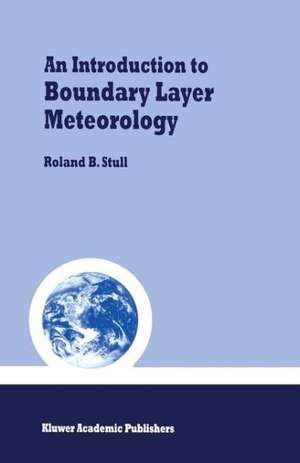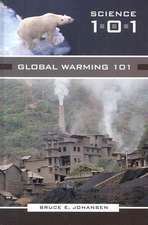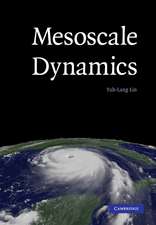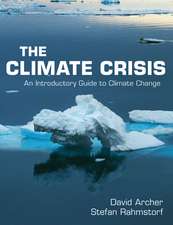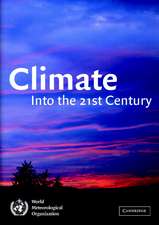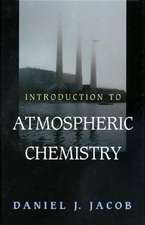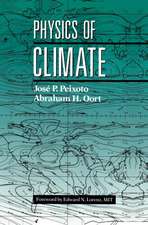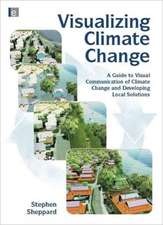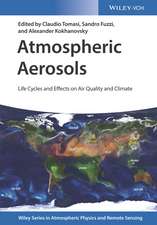An Introduction to Boundary Layer Meteorology: Atmospheric and Oceanographic Sciences Library, cartea 13
Autor Roland B. Stullen Limba Engleză Hardback – 31 iul 1988
The work should also be considered as a major reference and as a review of the literature, since it includes tables of parameterizatlons, procedures, filed experiments, useful constants, and graphs of various phenomena under a variety of conditions. It is assumed that the work will be used at the beginning graduate level for students with an undergraduate background in meteorology, but the author envisions, and has catered for, a heterogeneity in the background and experience of his readers.
| Toate formatele și edițiile | Preț | Express |
|---|---|---|
| Paperback (1) | 1749.62 lei 3-5 săpt. | +37.51 lei 6-12 zile |
| SPRINGER NETHERLANDS – 31 iul 1988 | 1749.62 lei 3-5 săpt. | +37.51 lei 6-12 zile |
| Hardback (1) | 2068.38 lei 6-8 săpt. | |
| SPRINGER NETHERLANDS – 31 iul 1988 | 2068.38 lei 6-8 săpt. |
Din seria Atmospheric and Oceanographic Sciences Library
- 18%
 Preț: 938.34 lei
Preț: 938.34 lei - 18%
 Preț: 943.64 lei
Preț: 943.64 lei - 18%
 Preț: 1133.17 lei
Preț: 1133.17 lei - 18%
 Preț: 929.39 lei
Preț: 929.39 lei - 18%
 Preț: 927.37 lei
Preț: 927.37 lei - 18%
 Preț: 1199.35 lei
Preț: 1199.35 lei - 18%
 Preț: 1202.02 lei
Preț: 1202.02 lei - 18%
 Preț: 932.97 lei
Preț: 932.97 lei - 15%
 Preț: 626.97 lei
Preț: 626.97 lei - 18%
 Preț: 1204.64 lei
Preț: 1204.64 lei - 18%
 Preț: 1390.19 lei
Preț: 1390.19 lei - 18%
 Preț: 931.40 lei
Preț: 931.40 lei - 24%
 Preț: 801.38 lei
Preț: 801.38 lei - 18%
 Preț: 1212.20 lei
Preț: 1212.20 lei - 18%
 Preț: 1200.93 lei
Preț: 1200.93 lei - 18%
 Preț: 940.97 lei
Preț: 940.97 lei - 18%
 Preț: 1364.21 lei
Preț: 1364.21 lei - 18%
 Preț: 927.99 lei
Preț: 927.99 lei - 18%
 Preț: 1210.67 lei
Preț: 1210.67 lei - 18%
 Preț: 1515.47 lei
Preț: 1515.47 lei - 18%
 Preț: 1362.36 lei
Preț: 1362.36 lei - 18%
 Preț: 1201.84 lei
Preț: 1201.84 lei - 18%
 Preț: 954.92 lei
Preț: 954.92 lei - 18%
 Preț: 933.10 lei
Preț: 933.10 lei - 18%
 Preț: 935.12 lei
Preț: 935.12 lei -
 Preț: 382.41 lei
Preț: 382.41 lei - 20%
 Preț: 585.97 lei
Preț: 585.97 lei
Preț: 2068.38 lei
Preț vechi: 2522.43 lei
-18% Nou
Puncte Express: 3103
Preț estimativ în valută:
395.97€ • 411.59$ • 328.30£
395.97€ • 411.59$ • 328.30£
Carte tipărită la comandă
Livrare economică 06-20 februarie 25
Preluare comenzi: 021 569.72.76
Specificații
ISBN-13: 9789027727688
ISBN-10: 9027727686
Pagini: 688
Ilustrații: XIV, 670 p.
Dimensiuni: 155 x 235 x 42 mm
Greutate: 1.08 kg
Ediția:1988
Editura: SPRINGER NETHERLANDS
Colecția Springer
Seria Atmospheric and Oceanographic Sciences Library
Locul publicării:Dordrecht, Netherlands
ISBN-10: 9027727686
Pagini: 688
Ilustrații: XIV, 670 p.
Dimensiuni: 155 x 235 x 42 mm
Greutate: 1.08 kg
Ediția:1988
Editura: SPRINGER NETHERLANDS
Colecția Springer
Seria Atmospheric and Oceanographic Sciences Library
Locul publicării:Dordrecht, Netherlands
Public țintă
ResearchCuprins
1 Mean Boundary Layer Characteristics.- 1.1 A boundary-layer definition.- 1.2 Wind and flow.- 1.3 Turbulent transport.- 1.4 Taylor’s hypothesis.- 1.5 Virtual potential temperature.- 1.6 Boundaiy layer depth and structure.- 1.7 Micrometeorology.- 1.8 Significance of the boundary layer.- 1.9 General references.- 1.10 References for this chapter.- 1.11 Exercises.- 2 Some Mathematical and Conceptual Tools: Part 1. Statistics.- 2.1 The significance of turbulence and its spectrum.- 2.2 The spectral gap.- 2.3 Mean and turbulent parts.- 2.4 Some basic statistical methods.- 2.5 Turbulence kinetic energy.- 2.6 Kinematic flux.- 2.7 Eddy flux.- 2.8 Summation notation.- 2.9 Stress.- 2.10 Friction velocity.- 2.11 References.- 2.12 Exercises.- 3 Application of the Governing Equations to Turbulent Flow.- 3.1 Methodology.- 3.2 Basic governing equations.- 3.3 Simplifications, approximations, and scaling arguments.- 3.4 Equations for mean variables in a turbulent flow.- 3.5 Summary of equations, with simplifications.- 3.6 Case studies.- 3.7 References.- 3.8 Exercises.- 4 Prognostic Equations for Turbulent Fluxes and Variances.- 4.1 Prognostic equations for the turbulent departures.- 4.2 Free convection scaling variables.- 4.3 Prognostic equations for variances.- 4.4 Prognostic equations for turbulent fluxes.- 4.5 References.- 4.6 Exercises.- 5 Turbulence Kinetic Energy, Stability, and Scaling.- 5.1 The TKE budget derivation.- 5.2 Contributions to the TKE budget.- 5.3 TKE budget contributions as a function of eddy size.- 5.4 Mean kinetic energy and its interaction with turbulence.- 5.5 Stability concepts.- 5.6 The Richardson number.- 5.7 The Obukhov length.- 5.8 Dimensionless gradients.- 5.9 Miscellaneous scaling parameters.- 5.10 Combined stability tables.- 5.11 References.- 5.12Exercises.- 6 Turbulence Closure Techniques.- 6.1 The closure problem.- 6.2 Parameterization rules.- 6.3 Local closure — zero and half order.- 6.4 Local closure — first order.- 6.5 Local closure — one-and-a-half order.- 6.6 Local closure — second order.- 6.7 Local closure — third order.- 6.8 Nonlocal closure — transilient turbulence theory.- 6.9 Nonlocal closure — spectral diffusivity theory.- 6.10 References.- 6.11 Exercises.- 7 Boundary Conditions and External Forcings.- 7.1 Effective surface turbulent flux.- 7.2 Heat budget at the surface.- 7.3 Radiation budget.- 7.4 Fluxes at interfaces.- 7.5 Partitioning of flux into sensible and latent portions.- 7.6 Flux to and from the ground.- 7.7 References.- 7.8 Exercises.- 8 Some Mathematical and Conceptual Tools: Part 2. Time Series.- 8.1 Time and space series.- 8.2 Autocorrelation.- 8.3 Structure function.- 8.4 Discrete Fourier transform.- 8.5 Fast Fourier Transform.- 8.6 Energy spectrum.- 8.7 Spectral characteristics.- 8.8 Spectra of two variables.- 8.9 Periodogram.- 8.10 Nonlocal spectra.- 8.11 Spectral decomposition of the TKE equation.- 8.12 References.- 8.13 Exercises.- 9 Similarity Theory.- 9.1 An overview.- 9.2 Buckingham Pi dimensional analysis methods.- 9.3 Scaling variables.- 9.4 Stable boundary layer similarity relationship lists.- 9.5 Neutral boundary layer similarity relationship lists.- 9.6 Convective boundary layer similarity relationship lists.- 9.7 The log wind profile.- 9.8 Rossby-number similarity and profile matching.- 9.9 Spectral similarity.- 9.10 Similarity scaling domains.- 9.11 References.- 9.12 Exercises.- 10 Measurement and Simulation Techniques.- 10.1 Sensor and measurement categories.- 10.2 Sensor lists.- 10.3 Active remote sensor observations of morphology.- 10.4 Instrumentplatforms.- 10.5 Field experiments.- 10.6 Simulation methods.- 10.7 Analysis methods.- 10.8 References.- 10.9 Exercises.- 11 Convective Mixed Layer.- 11.1 The unstable surface layer.- 11.2 The mixed layer.- 11.3 Entrainment zone.- 11.4 Entrainment velocity and its parameterization.- 11.5 Subsidence and advection.- 11.6 References.- 11.7 Exercises.- 12 Stable Boundary Layer.- 12.1 Mean Characteristics.- 12.2 Processes.- 12.3 Evolution.- 12.4 Other Depth Models.- 12.5 Low-level (nocturnal) jet.- 12.6 Buoyancy (gravity) waves.- 12.7 Terrain slope and drainage winds.- 12.8 References.- 12.9 Exercises.- 13 Boundary Layer Clouds.- 13.1 Thermodynamics.- 13.2 Radiation.- 13.3 Cloud entrainment mechanisms.- 13.4 Fair-weather cumulus.- 13.5 Stratocumulus.- 13.6 Fog.- 13.7 References.- 13.8 Exercises.- 14 Geographic Effects.- 14.1 Geographically generated local winds.- 14.2 Geographically modified flow.- 14.3 Urban heat island.- 14.4 References.- 14.5 Exercises.- Appendices.- A. Scaling variables and dimensionless groups.- B. Notation.- C. Useful constants parameters and conversion factors.- D. Derivation of virtual potential temperature.- Errata section.
Recenzii
`The book is an impressive work and will be of value to many students, researchers and operational meteorologists,'
Journal of Fluid Mechanics, 224, 1991
`... the detailed excellent treatment of the broad field of boundary layer meteorology makes the book most valuable, not only to students, but to anyone interested in turbulence in the boundary layer.'
J. Borkowski, Pageoph, 133:1, 1990
'In summary the book is highly recommended for graduate students of meteorology as well as air chemists and aerosol physicists wanting to interpret their measured data in terms of boundary layer phenomena.'
Atmospheric Research 26, 1991
`Das Buch is allemal eine Investition wert und wird für viele Jahre ein Standardwerk über Grenzschichtmeteorologie bleiben. Einen 'Stull' sollte jeder (Grenzschicht-)Meteorologe besitzen.'
Meteorologische Rundschau, 41:6
`Das Buch ist es wert, einem großen Leserkreis zugänglich gemacht zu werden.Es spricht nicht nur den Studenten an, sondern jeden Meteorologen bis hin zum Experten aus ausgewählten Gebieten der atmosphärischen Grenzschicht. Der anschauliche and leichte Zugang zur Thematik ermöglicht aber auch vielen Wissenschaftlern benachbarten Disziplinen, die sich in ihrer Tätigkeit mit meteorologischen Prozessen der atmosphärischen Grenzschicht auseindersetzen müssen, eine rasche und einfache Einarbeitung.'
Zeitschrift für Meterologie, 40, 1990
Journal of Fluid Mechanics, 224, 1991
`... the detailed excellent treatment of the broad field of boundary layer meteorology makes the book most valuable, not only to students, but to anyone interested in turbulence in the boundary layer.'
J. Borkowski, Pageoph, 133:1, 1990
'In summary the book is highly recommended for graduate students of meteorology as well as air chemists and aerosol physicists wanting to interpret their measured data in terms of boundary layer phenomena.'
Atmospheric Research 26, 1991
`Das Buch is allemal eine Investition wert und wird für viele Jahre ein Standardwerk über Grenzschichtmeteorologie bleiben. Einen 'Stull' sollte jeder (Grenzschicht-)Meteorologe besitzen.'
Meteorologische Rundschau, 41:6
`Das Buch ist es wert, einem großen Leserkreis zugänglich gemacht zu werden.Es spricht nicht nur den Studenten an, sondern jeden Meteorologen bis hin zum Experten aus ausgewählten Gebieten der atmosphärischen Grenzschicht. Der anschauliche and leichte Zugang zur Thematik ermöglicht aber auch vielen Wissenschaftlern benachbarten Disziplinen, die sich in ihrer Tätigkeit mit meteorologischen Prozessen der atmosphärischen Grenzschicht auseindersetzen müssen, eine rasche und einfache Einarbeitung.'
Zeitschrift für Meterologie, 40, 1990
Textul de pe ultima copertă
Part of the excitement in boundary-layer meteorology is the challenge associated with turbulent flow - one of the unsolved problems in classical physics. The flavor of the challenges and the excitement associated with the study of the atmospheric boundary layer are captured in this textbook.
The work should also be considered as a major reference and as a review of the literature, since it includes tables of parameterizations, procedures, field experiments, useful constants, and graphs of various phenomena under a variety of conditions.
The author envisions, and has catered for, a heterogeneity in the background and experience of his readers. Therefore, the book is useful to beginning graduate students as well as established scientists.
'The book is a welcome addition to the boundary-layer literature, one of the first truly comprehensive texts... ' (Boundary-Layer Meteorology)
'I found, in fact, that within hours of the book's arrival, I had consulted it twice..' (AMS Bulletin, 1989)
'Stull's book is destined to be the overwhelmingly favorite text and general reference in atmospheric turbulence and boundary layer physics during the1990s'. (AMS Bulletin, 1990)
'.. a good introductory textbook which is likely to be well used in the coming years.' (Quarterly Journal of the Royal Meteorological Society)
The work should also be considered as a major reference and as a review of the literature, since it includes tables of parameterizations, procedures, field experiments, useful constants, and graphs of various phenomena under a variety of conditions.
The author envisions, and has catered for, a heterogeneity in the background and experience of his readers. Therefore, the book is useful to beginning graduate students as well as established scientists.
'The book is a welcome addition to the boundary-layer literature, one of the first truly comprehensive texts... ' (Boundary-Layer Meteorology)
'I found, in fact, that within hours of the book's arrival, I had consulted it twice..' (AMS Bulletin, 1989)
'Stull's book is destined to be the overwhelmingly favorite text and general reference in atmospheric turbulence and boundary layer physics during the1990s'. (AMS Bulletin, 1990)
'.. a good introductory textbook which is likely to be well used in the coming years.' (Quarterly Journal of the Royal Meteorological Society)
